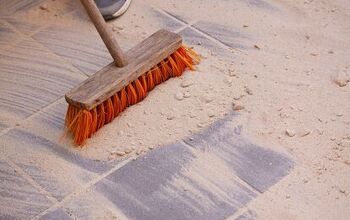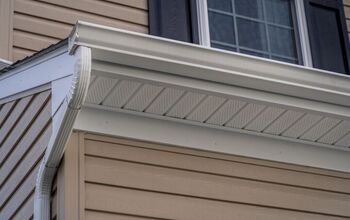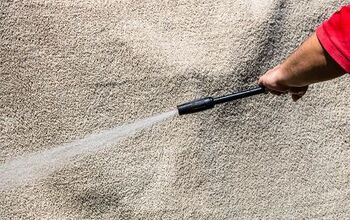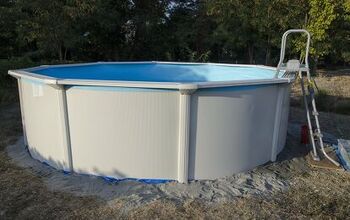Can You Pressure Wash Polymeric Sand? (Find Out Now!)

When you’re creating your dream garden, the chances are high that pavers are going to be involved. You can make beautiful paths, patios, or small areas for birdbaths. Polymeric sand is a handy ingredient that acts as a cement-like material to keep the pavers in place.
You can pressure wash polymeric sand if you use cold water and the sand has been set. Never pressure wash polymeric sand immediately after you install it because it will ruin it. Always use cold water because warm water can warp the polymeric sand.
Below we’ll talk about how you can clean pavers where you’ve applied polymeric sand. In case this type of filler isn’t meeting your needs, I’ve also added a handful of alternatives. The handy buyer’s guide will give you a good idea of what you can expect to pay as well.
Do You Need Power Washing Services?
Get free, zero-commitment quotes from pro contractors near you.

Applying Polymeric Sand
The key to cleaning polymeric sand-filled pavers correctly actually lies in the application of the sand itself. If it isn’t applied correctly, things like a pressure washer will cause more harm than good. These are the steps to properly use the sand and get a seamless finish.
Step 1: Sweeping the Sand
The first thing you’ll want to do is pour the sand out in one area after laying your pavers. Sweep the polymeric sand into all of the joints. Make sure that this is done evenly to give a more cohesive final look.
Step 2: Compact the Sand Down
Next, compact or tamp the pavers and sand to ensure that all cracks are covered. While you can add more sand later, it’s less work to do this before moving onto step three.
Step 3: Repeat the Process
For the third step, simply repeat the first two steps. Adding polymeric sand in rounds allows it to settle evenly in every crack and crevice. When sweeping, it’s important not to clean too hard, so the sand to go off into the sides.
Step 4: Filling Between Pavers
Continue sweeping in the sand, but don’t tamp it down this time. You’ll want the filler as close to the tops of the pavers as possible. Doing so makes an even final surface and reduces any unwanted dips or divots.
Step 5: Getting Rid of Excess
This step is essential: make sure there isn’t any sand leftover on the pavers themselves. If there is, sweep it off or use a leaf blower at an angle. Once you wet the sand, it can be incredibly challenging to remove.
Step 6: Water It Down
Spray water all over the paved areas using a misting setting. A harsh water pressure, like a pressure washer, will kick up the sand and make a mess. Start by spraying higher and slowly get lower as you go.
Step 7: Let It Cure
After it’s completely misted, let it sit for about 15 minutes. Then you’ll want to go in again with an even lighter mist. Finally, allow it to cure for 24 hours before any traffic goes on the pavers.
It’s a good idea to cover it with a lifted tarp if any rain or severe weather is expected. Even while it’s curing, you don’t want polymeric sand to get wet again. It can be a pain to remove, and it’s best to take small steps to avoid that from happening.
How Do You Clean Pavers With Polymeric Sand?
After the polymeric sand is completely cured, you can use your pressure washer to clean it. There are several easy ways to make your patio pavers look brand new. Here are the simplest (and cheapest) ways to get the job done.
Pressure Washing
A pressure washer allows you to remove tough stains and get rid of tough buildup. Things like grass, leaves, and spills can leave ugly marks on your patio. One of the crucial tips when it comes to using a pressure washer is to make sure the water isn’t too warm.
If polymeric sand is met with a heat of 185 degrees, it can become dislodged. Another tip is to not go full blast using this cleaning method either. Only use a higher pressure when trying to remove stains.
Something to note if you do plan on using a pressure washer is the need to reapply sand. This can be a spendy way to clean your patio if you do it often. The average home washes their patio three to four times per year.
Soap and Water
If you need to clean your pavers more often, that’s totally okay. Get a bowl with some warm, soapy water. Again, watch the temperature of the water when working with polymeric sand. You can get a brush, cloth, or sponge, and spot clean the dirty areas.
White Vinegar and Water
As a homeowner, you’ll eventually learn that white vinegar is an excellent cleaning agent. It’s essential to use white vinegar, as dark can stain pavers. Mix a one to one ration and pour it all over your patio.
Let this sit for around an hour. Then, remove it using soap and water, scrubbing any tough stains in the process. Allow it to dry completely before walking on it.
Use a Broom
To prevent your pavers from getting stained in the first place, regularly sweeping them can help. You’ll want to do this at least once a week, more if you live somewhere with a lot of trees and plants.
If you know it’s going to rain soon, do a quick sweep over the patio. The rain can cause things like leaves to leave stains.
Polymeric Sand Alternatives
There are three main alternatives to polymeric sand. They all have their own pros and cons. If you find that polymeric sand isn’t for you, consider using one of these three fillers instead.
Cement
The most common alternative is to use cement. It’s known to keep pavers in their place by creating a strong bond. Cement works very similarly to glue, and it takes about eight pounds of cement to fill a 4×4 patio.
Just like polymeric sand, cement has a curing time as well. It can take as little as 24 hours but may take several days to be completely dry.
Builder’s Sand
Builder’s sand is the most common replacement for polymeric sand. It’s incredibly easy to access, and it’s relatively inexpensive. It’s coarse and has been used with paver joints for several years.
Something that makes people avoid builder’s sand is that it can get eroded due to things like continuous rainfall or strong winds.
Stone Dust
Lastly, stone dust is another alternative to polymeric sand. It’s often used as a bedding layer but can also be used between pavers. Another name for it commonly goes by is “rock dust.”
While it is a great replacement, not every store will have it available. It also doesn’t stay in place like cement does. It’s an excellent product for landscaping and can give a smooth layer underneath pavers.
Cost of Using Polymeric Sand
Pricing for polymeric can vary from one store to another and region to region. It’s common for prices to fall between $20 and $40 per 50-pound bag. In the long run, using polymeric sand will save you money from not having to relay the interlocking pavers as often.
Polymeric Sand Price vs. Alternatives
| Material | Walmart | Home Depot | Menards | Lowe’s |
| Polymeric sand | $65/ 50 lbs | $10/ 50 lbs | $25/ 50 lbs | $22/ 40 lbs |
| Cement | $12/ 60 lbs | $3.50/ 60 lbs | $5/ 60 lbs | $11/ 70 lbs |
| Builder’s sand | $3/ 50 lbs | $6/ 50 lbs | $5/ 60 lbs | $4/ 50 lbs |
| Stone dust | N/A | $10/ 50 lbs | $15/ 50 lbs | $5/ 40 lbs |
Do You Need Power Washing Services?
Get free, zero-commitment quotes from pro contractors near you.

Related Questions
What happens if polymeric sand gets rained on?
If it recently rained and the surface is still wet or damp, avoid putting in polymeric sand. It’s essential to the setting process of this type of sand for it to be dry from the moment it’s poured. If there’s a hard rain on polymeric sand that isn’t completely set, the sand could go all over the pavers’ top. The unfortunate truth is that if this happens, you’ll have to replace the sand. To avoid this from happening in the first place, consider putting a tarp over where you poured in polymeric sand.
How do you remove the haze from polymeric sand?
Some polymeric sands contain cement, and this can create an unflattering haze that can be hard to remove. The most common way to get rid of the haze is to acid wash the surface until it’s noticeably clearer. There are specific polymeric sand cleaners that are designed to de-haze the finish.
Can weeds grow through polymeric sand?
I like to think of polymeric sand as an outdoor version of grout. Once it’s completely dried and cured, it creates a cement-like consistency. If properly installed, weeds won’t grow between the joins, and the sand will stay in place.

Kirstin is a passionate writer who loves helping people learn new things when it comes to home improvement. When she's not behind a keyboard, she enjoys DIY projects, crafts, spending time with her pets, and making videos. She hopes that with all she writes, someone is finding a solution to their home improvement needs.
More by Kirstin Harrington



























